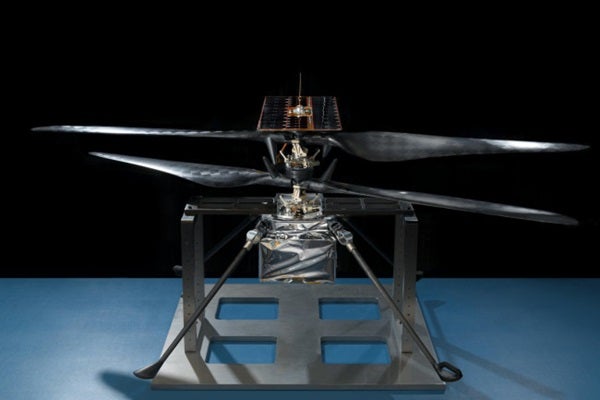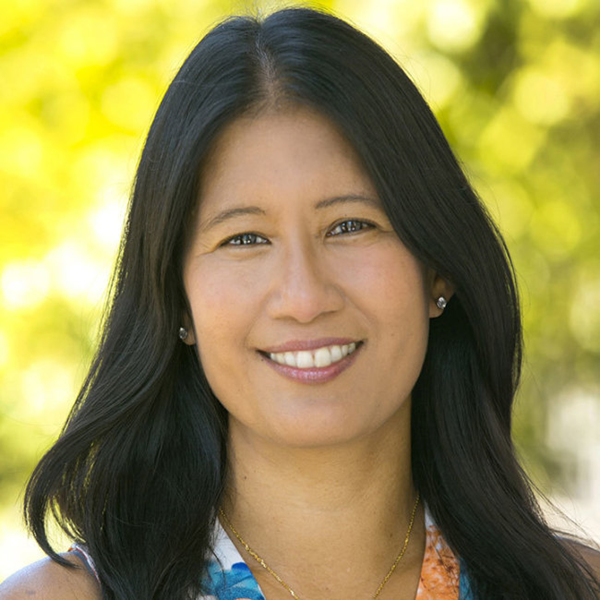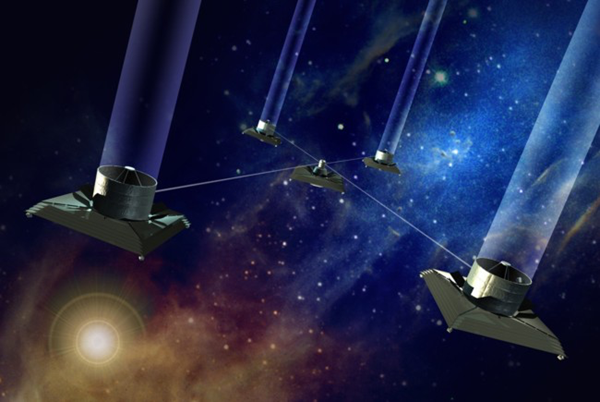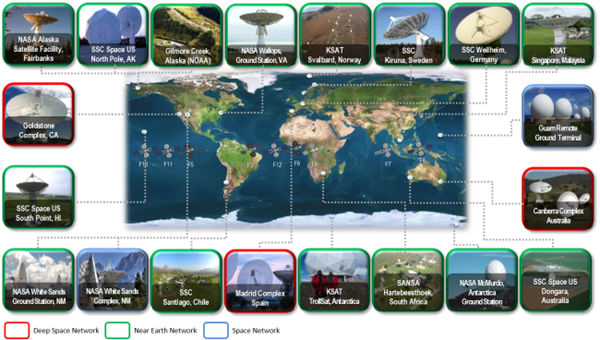The Jet Propulsion Laboratory in Pasadena, California — generally known as a NASA center, though it is managed by Caltech — is probably the world’s premier outpost of otherworldly engineering. It is a place where space dreamers go to translate those dreams into software and circuits and mechanical systems. MiMi Aung, the project manager for the Ingenuity helicopter that is about to take flight on Mars, is a quintessential example of that marvelous synthesis.
Aung grew up in Burma (Myanmar), equally fascinated by the mystery of the night sky and the beauty of numbers. (Bob Balaram, who originated the idea of the Mars Helicopter, is originally from India; Håvard Grip, the helicopter’s Chief Pilot, is from Norway. The dream knows no national boundaries.) She found her way to JPL and worked on the technical side of some of the most lyrical projects at the lab, including the Deep Space Network, which talks to interplanetary spacecraft, and the Terrestrial Planet Finder project, which pioneered the optics needed to study Earths around other stars.
Now the Ingenuity helicopter is prepared to add an entirely new dimension to planetary exploration by taking the first, tentative flights on Mars. For every headline-grabbing moment like that, there were years of agonizing and thrilling engineering work that came before. I spoke with Aung about the secret life of the space engineer. (For more about the Mars helicopter in particular, see my previous column.)
A lightly edited version of our conversation follows.
How does somebody grow up to become the systems engineer overseeing a helicopter on another planet?
I have to start with my parents really. They both came to the US [from Burma] and got their PhDs — my mother’s in math and my father’s in food science, which is a special branch of chemistry. I was actually born on the University of Illinois campus.
When they finished their PhDs, they went back to Burma and I grew up there from when I was 2 to 11. Then when I was 11 and a half, we moved to Malaysia. They’re professors in a university there. But when I was 16, my parents really wanted me to continue on the educational track in the US, so they sent me over.
You came to the United States all by yourself at age 16?
I was taken in by my parents’ American friends from graduate school. I got on a plane and flew to the other side of the world. I didn’t even have a picture of these people, because this is back in ’83. I asked, “How will I know you?” and they said, “Don’t worry, we’ll see you,” because I was flying into Decatur, Illinois, which is a tiny airport. There they were. They said, “Hi, MiMi, we’re Anne and Walt.”
It was about people helping people. Walt and Anne really took it seriously, so they talked me through my senior year in high school and helped me find my path.
When I was 16, all I knew was I loved math. I remember writing to somebody I was dating — you know how back then you used to write letters? I wrote a letter saying, “I have found true love.” What I meant was, “I love math.” It was head over heels.
But my parents said, “No, we want you to have an application.” Then in my junior year at the University of Illinois, I was taking a class on signal processing communications and the probability and statistics. My interests all coincided in that. It was just the happiest year. I knew what I wanted to do.
You had quite a journey from Burma to the University of Illinois. How did you end up at the Jet Propulsion Lab, JPL?
When I finished my master’s degree, one of my professors made a fortuitous comment: “You know, The Deep Space Network in NASA, JPL, they process signals.” [Note: The DSN is a global network of radio antennas that communicates with distant spacecraft.] I was young, I’d always thought I wanted to work in space. That comment triggered a reaction in me: “Wow, space signals!” I managed to get a job there modeling the signals.
I soon learned that there are equations, and then there’s a reality, right? There’s noise, or the filter didn’t work as well as you did in your beautiful simulation. The thing I love about fundamental engineering is that, at the end, there are no excuses. It has to work, so you find a way to make it work. The Mars Helicopter is the ultimate example of that idea.
Along the way, you also studied how to fly spacecraft in formation so that NASA could build the Terrestrial Planet Finder – a hugely ambitious mission to find Earth-like planets around other stars.
You’re making me walk down memory lane. Oh my gosh. I get emotional.
My supervisor back then, Ernie Stone, was a fantastic mentor. He connected me with a project called StarLight . The concept was that you’d have two spacecraft that are a kilometer apart, and you’d combine the light from the two and cancel the light from a star so that you could find an Earth-like planet around it. [Note: This technique, known as long-baseline optical interferometry, is highly challenging on Earth and has never been attempted in space.]
StarLight needed a sensor to keep the two platforms in place, a kilometer apart but at centimeter-level accuracy that far apart. It’s done by transmitting and receiving and transmitting and receiving with multiple antennas. They needed an engineer who could manage the algorithms and really apply them, so they put me onto that spacecraft project. That’s how I got into the planet finding.
You know how life works, right? I loved the project because I was thrown into a totally different world. When you work on a space mission, you have to be so safe, because once you launch, you can’t fix things. You can’t just try stuff like you can on the ground.
And emotionally, one of the things that have always driven me is wondering, are we alone? Is there life out there? Well, here’s the ultimate thing. You’re studying the planets around other stars, trying to see if they are inhabited. It was magic, right? Well, first StarLight was canceled. Then I got promoted to lead for all formation flying for Terrestrial Planet Finder, and it got canceled.
Larry Simmons, the director for astrophysics at the time, told me, “You’ll be okay over time. It will be okay.” I didn’t know what he meant at first. Then after six months or a year, I realized how heartbroken I was. I was broken-hearted for a long time.
It’s hard for most people to understand what it’s like to work on a project you love for years, and then it just goes away. That’s not the way most of us operate.
StarLight gave me that fear of losing something that you’re really into. I have to tell you, though, something good that came out of it. It played a big part in the development of the Mars helicopter.
What do you mean by that? How did the failure of Terrestrial Planet Finder help inspire the success of the Ingenuity helicopter?
For the rest of my career, I never took anything for granted. I was careful every single second. I was the project manager with the helicopter, which started as a very uncertain project. Is it even possible? We had to prove our way to go forward.
In the team meetings, I’d say things like, “We can’t take it for granted. This looks good, but what’s the next thing? What’s the next thing after that?” And I knew we must communicate clearly. We can’t be like mumbo-jumbo. We have to talk to the Mars 2020 [Persevrance rover] folks who are going to accommodate the helicopter. [NASA] Headquarters has to know what we’re doing. Our management has to know. Our team has to know.
I did make lemonade out of lemons. It is something that drove me and I continue to be very careful. I really don’t take anything for granted, for any moment.
And the technology from StarLight and Terrestrial Planet Finder is still there if we find an Earth-like planet and want to get a better look, right?
Yeah! The knowledge of what we accomplished with StarLight and TPF stays in the organizations. Things like the autonomous formation flying sensor that I was in charge of. That technology doesn’t go away, so if the planet-finding starts to blossom, they would go back to the same line organization. The sensor we did, the knowledge is not lost.
When did you begin the work that would lead to the Ingenuity helicopter?
It was around 2012 or so. By then, I had moved on to the spacecraft side of the house [at JPL]. I was the head of the guidance and control section. Then I was promoted to be the deputy manager for the autonomous systems division, which does the spacecraft onboard avionics for flight computers and flight software and guidance and control, power, and robotics.
Charles Elachi was the director of JPL at the time. Regularly, he goes on these division tours. Since I was a deputy division manager for autonomous systems division, I was the host to him that one day. We showed him a lab where we were testing autonomous onboard navigation algorithms by using drones in a facility. And I remember that we came out of that lab and he asked, “Hey, why aren’t we flying at Mars?”
I’m a guidance and control geek. I was used to algorithms for jet power, engine power, landing. Those are the kinds of things I’m used to thinking about. I remember looking at him funny, going, “Fly, like a rotorcraft?”
That’s funny. You’re the project manager for Ingenuity, but originally you didn’t think flight on another planet was possible?
If I was going to apply my expertise, I wanted to fly propusively. I’m being brutally honest. But the conversation went on, and now I was getting pulled in. Charles’s question sent us to Bob Balaram, who had done research in rotocraft for Mars in the 1990s. JPL funded Bob to start dusting off the results from the 1990s.
At this point, Bob takes an initial look and says, “Hmm…with the advancement of technology, it could be possible now, because things have become lighter. If we’re smart, maybe we can do it.”
The world expert in Mars flight told you “maybe” it’s possible? I can see why you were skeptical at first.
Right. There was funding for some months, we did a review, and we saw it had become more feasible. Then he decision came to go onto the next level, where we build a one-third scale vehicle and see if we can actually fly it. We had lift experiments on rails: The blade’s spinning, but it’s going up on guided rails, to convince people.
There was still a significant population that thought [flying on Mars] was just was impossible. Crazy. Even the really hardcore, great engineering folks. There are a few who later admitted, “Hey, you guys were right. I was wrong.”
People thought the engineering challenge of flying on Mars was just too tough to solve?
Yes, yes, yes. And also the whole idea was counterintuitive. I think in that case, it went beyond the equations. People were going by intuition so much, and the intuition really dominated. It was really hard to overcome. So when [the JPL managers] went to the lift test, they said, “All right, we need a dedicated team to do tech demonstrations. Let’s start with the one-third scale vehicle.” To convince everyone.
I was assigned to start taking the lead on from that point. So I did my regular deputy division manager job as well as additional duty of doing this helicopter. That’s when I started to get wrapped up in the project – after I got into the leadership role, looking at the analysis that showed how we need to model the lift and the drag. It’s not just some cartoon anymore. You have to model in pieces and integrate them and think about sensors and the mass, like how do you build it light enough?
Was there a moment when you realized: This is not a crazy idea, this Mars helicopter is possible?
I remember the moment of clarity. I was in a conference room. We were preparing for the next major briefing to headquarters [about the Mars helicopter], and somebody in the room asked, “What do you think probability of this working and us being allowed to go forward to try it?” Somebody else said, “50 percent.”
Something snapped in my head and I remember going, “Nope, it’s not 50 percent anymore. It’s like 80 percent. It’s something high.” I knew at that moment, the project is ours to lose. It was one of those moments when you see the whole problem, and then you just start making sure that everyone works together to make it happen.
I’m very respectful because I come from the algorithmic side. I was able to get everybody to talk to me and then to make sure everybody talked to each other. That was the secret sauce to make the Mars helicopter work.
One time, there was a problem with something with the helicopter blade. There was a modeling issue that we couldn’t solve. We had all the conversation, and by the end of it, there was a software solution that took care of the problem. Everybody had to contribute. Every single subsystem [in Ingenuity] required an innovation to happen.
Was there another lightbulb moment when it became clear to you that, yes, this helicopter is ready to send to Mars?
It happened when we built the prototype system. After that little one third scale, we did a full-scale model. And there was a moment when it came in, even before we flew it. This is when we worked with AeroVironment, a company in Simi Valley who built the rotor system and the landing gear and the substrate for the solar panel. They showed up with a rotor system that was exactly the way we specified it.
That was one moment. The second moment was when we spun full speed for the first time. I think that’s when I really knew.
And at that point you really became the Mars-helicopter engineer?
I still had two jobs at the time, but you can’t ride two horses. I must’ve felt confident to leave my very nice job in spacecraft systems. Autonomous systems is something I love. It’s a vision of things I want to do for future. This is psychologically the moment when I said, “This is it. And if it doesn’t work, I’ll have no regrets.”













